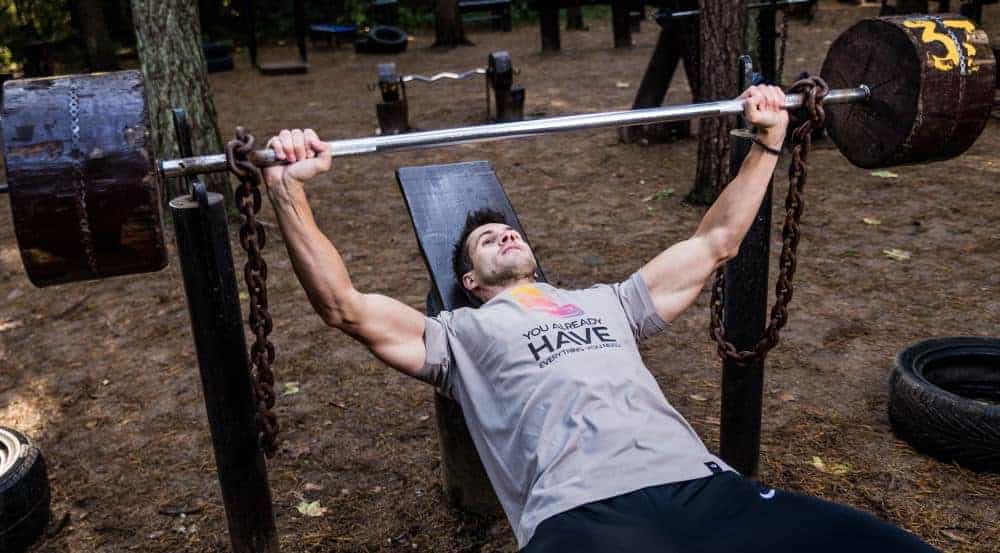In weight training, the training volume indicates how much work we did or how much weight our muscles moved during one workout.
But what’s the benefit?
To put it simply: By knowing the volume, we can compare our workouts and assess if we have become stronger or weaker.

According to the result, we determine if it is necessary to make adjustments to our training program.
The Volume, also called workload, can be calculated as follows:
Volume = Weight x Repetitions (reps) x Sets
In order to build muscles, the optimal volume for hypertrophy seems to be the most important variable.
But before you think: damn I just need to add more and more volume to get bigger and stronger, I am sorry to disappoint you, but unfortunately, it doesn’t work like that. There are other variables which need to be taken into consideration.
For example, the intensity of your workout, frequency, and muscle stress play a major role in muscle hypertrophy as well.
The volume is therefore not the only variable that is relevant, but the most important.
Furthermore, it seems like the optimal volume for hypertrophy is as important for building strength as muscles are!
This may sound a bit confusing at first glance, but it’s pretty logical!
When our muscles grow and get bigger, they get stronger simultaneously.
Which means bigger muscles can move heavier weights. BUT, of course only up to a certain point, especially as natural athletes.
The same applies to build muscles. Adding more volume is only effective until a certain point. Where this point is located cannot be answered at a flat rate. Everybody is unique and individual difference is key.
That’s also why it’s impossible to generalize values that work fine for everyone.
Hence it is important for you guys, to give many things a go and test what you feel the most comfortable with. However, that does not mean you should train light. But figure out what your body responds best to.
Other important aspects to consider when talking about the optimal volume for hypertrophy are the circumstances.
What do I mean with circumstances?
Let me give you an example:
Imagine Peter squats 3 sets of 10 reps with 100kg in his workout. His friend Mike prefers to do leg press with 3 sets of 10 reps with 200kg.
Solely from the workload (Peter = 3000kg and Mike = 6000kg), we would assume that Mike is stronger than Peter.
But is it that simple to assess?
Sorry, I have to temper your delight. It’s not that simple.
Don’t worry, it’s not that complicated either.
It is important to take the other variables into consideration for the assessment as well.
Although Mike probably increased his muscle cross-section by doing leg press instead of squats, nevertheless that does not necessarily correlate with improved strength in squats at the same time.
In other words, during the period where Mike switched to leg press, proper squats technique, and execution sank into obscurity.
Why can we say that?
Strength is always very dependent on the exercise and influenced by different aspects (along with your muscle cross-section), e.g. the neural system (CNS) and mind.
Altogether, we can describe this variable as “Skill“.
If we refer back to Mike and Peter from the previous example, not only the did the interaction between all involved muscles (intermuscular coordination) decrease, but so did the (intramuscular coordination) inside of the muscles too.
Additionally, other factors like self-confidence might decrease, which in turn can affect performance in specific exercises tremendously.
That seems logical, right?
Think about it.
If we do benchpress at least 2 times/week, we feel more confident and familiar with proper technique and execution.
On the opposite, if you need to take a break from certain exercises for some time, you’ll feel unfamiliar and rather unwell when doing that exercise after your break.
So, the increasing volume does improve strength for two reasons.
Firstly, bigger grown muscles and secondly, through the constant repetition of the same movement patterns.
It is important to know, that we get stronger in the particular rep ranges we constantly perform. It makes sense that if your training program always provides for 3 sets of 10 reps that you are strongest in that very rep range.
For all of you that want to make a little caveat now: “I know a guy that does not even look half as big as me, but benches more than I do”.
How is that possible with regard to what I just said?
Here is a little objection.
Of course, we always need to consider the same person. Differences in leverage position and other variables diverge between individuals.
This makes it impossible to compare the strength of athletes only based on muscle size.
But how is it possible that someone with apparently smaller chest muscles can bench more than an advanced, bigger athlete?
Imagine two persons who are exactly build up the same, genetically 100% identical. However, there is one small but significant difference.
One person has shorter arms.
Imagine both persons are doing bench press with 100kg.
Person A who has longer arms needs to cover a greater range of motion than Person B.
In other words, he needs to carry the weight for a longer period of time, and that eventually results in a greater workload.
In the end, more muscular strength is expended although both athletes are genetically identical.
This shows us how important seemingly “small” factors can be.
Let me make this more clear with another example:
Imagine you have two cars. Car A has 500HP and Car B 800HP.
Does it inevitably mean Car B will be faster because of its 300HP advantage?
No, not necessarily. Albeit, if both cars can equally convert their power onto the streets, Car B most likely is going to be faster.
As we understand that the optimal volume for hypertrophy is the most important parameter for muscle growth, there is still one question left.
Does more volume mean more muscle growth?
Well, additional volume positively affects muscle growth, that’s for sure. Yet, unfortunately, it is not an endless formula.
Volume only accounts for better muscle growth up to a certain point.
Beyond that point, the positive impact starts to stagnate can even decrease.
Sooner or later, when increasing volume too much, you will reach a point where your body is not able to fully recover from its last workout.
This is also called the Maximum Recoverable Volume (MRV).
Before we move on, let’s shortly summarize some key aspects that we covered so far.
- The highest volume which stimulates the biggest muscle growth but does not negatively affect our recovery time is most desirable.
- It can be said that with each additional set our performance will decrease. Therefore, doubling the volume does not result in doubled muscle growth.
- Ultimately, we can say that the optimal volume for hypertrophy has a strong interaction with the frequency, intensity, utilization and even the selection of exercises.
Why is frequency important?
Since volume is cumulative (accumulative), it is important to look at it in a certain timeframe (weekly/cycle to cycle) and not just in a single training session.
Why is intensity important?
High volume with high intensity is apparently more exhausting than the same volume with low intensity.
The locomotory system, as well as the neural system (CNS), are both strained more through high-intensity training.
Our body likewise needs more time to recover.

Why is the selection of exercises important?
It is pretty obvious that you cannot compare the volume of squats with the volume of leg extensions.
Again, both exercises put a totally different level of stress on our muscles which is why the selection of exercises contemplates with the optimal volume for hypertrophy.
Why is workload important?
A high workload means, that your workouts come close to muscle failure. You can imagine that when finishing a set 8 reps before muscle failure, compared to finishing a set 2 reps before failure, does not exert the same level of exhaustion.
Before we finally get more in-depth about specific recommendation values, let’s briefly point out some major aspects.
Take home message
- The optimal volume for hypertrophy is the most important variable, BUT not the only variable that needs to be considered to build muscle and strength.
- Higher Volume equals bigger muscle size, BUT only until a certain point
- Volume correlates with practice: the more often we do a certain exercise, the higher will be our “skill” (execution, neural system, mind, etc).
- The optimal volume for hypertrophy has a strong interaction with frequency, intensity, workload, and selection of exercises.
- Volume is strongly dependent on the exercise and cannot be compared with different exercises.
Volume recommendations (repetitions)
Generally, a beginner can already achieve decent progress with a quite low intensity of around 15-25 reps for each muscle.
To achieve this, a medium frequency with approximately 3x workouts per week is absolutely sufficient.
Keep in mind:
1. The optimal volume for hypertrophy is dependent on your training level.
For instance, someone who has been working out for 10 years and squats 250kg obviously needs more time to further increase his performance than someone who just started off.
2. Because of individual anatomical differences, identical volumes do not have the same effects for everybody.
Referring back to our example:
If Person A has longer arms than Person B and both bench press the same weight (100kg), Person A must put in more effort to carry the weight because of his bigger/greater range of motion.
W (workload) = F (power) x S (range of motion)
That means the longer your arms, the bigger your range of motion and the greater the required effort for the exercise.
3. Some muscles grow better with high volume and others with low volume.
These recommendations should always be seen as benchmarks and not as fixed values. Everybody is unique and that is the reason volume cannot be generalized flat-rate.
Everybody probably has a muscle that literally grows without much effort whereas other muscles seemingly do not respond to any stimulus at all.
4. The recommendations are termed in “total reps” because different exercises have different volumes.
For example:
Someone who does 200kg at the leg press can probably squat 70-90kg with the same level of effort. Here’s the deal, one set of 10 reps gives us a volume of a) 2000kg and b) 700-900kg.
But does that imply, that leg press is a better option than squats?
No, certainly not.
In this case, squats as a basic compound exercise just involve more muscles and require more body tension.
It is better to compare the 10 reps with each other if they roughly stress the same muscles and are both close to muscle failure. Only then equal stress on the muscles is given.
Summing up, it can be said that: the optimal volume for hypertrophy which is necessary for the ideal progress, is indeed very individual!
Finally, we get to concrete numbers. You can use them as benchmarks, start with them and make adjustments later on.
How much volume do our muscles need to grow?
Generally speaking, around 120-210 heavy reps / per muscle / each week
If you train every muscle 3 times a week, this would result in 40-70 reps and if you train 2 times a week, around 60-105 reps each workout.
Always keep in mind that these recommendations are only reference points and that you need to make adjustments over time, based on your own assessment.
Some of you may have muscles that react relatively bad to resistance training.
Others may already be close to your genetical limitations. It might even be the case that you need 220 to 230 reps to stimulate optimal muscle growth.
But, on average, you can assume that you most likely will end up in a range between 120-210 reps.
Always remember that we are talking about heavy reps – warm-up reps do not count.
Only heavy “work sets” contribute to your optimal volume for hypertrophy. The only exception is heavy warm-up sets (80-90% of your end weight).
Another significant variable that you should be aware of is the so-called overlapping.
What is overlapping?
To give an illustration:
Imagine you are doing 70 heavy reps of bench press.
Does this only count as 70 reps for chest? For chest and shoulders? Or chest shoulders and triceps?
Even though bench press should primarily involve the chest, you can’t fully remove shoulders and triceps from this exercise. That’s why they are always stimulated to at least some extent.
For your chest, it is pretty obvious.
You did 70 reps of an exercise which is supposed to primarily work on your chest. Therefore you can count all those 70 reps as chest volume.
Considering the other muscles involved, it becomes a bit more complicated.
Your anatomy and technique also play an important role which is why the values can vary greatly.
To give you another example, someone with predominant front delts will most likely engage his delts more than the average person.
In order to solve this problem, we can use the 1/3 formula for all heavy involved muscles.
What does that mean?
If you are benching 70 reps, multiply your reps with 1/3.
Having done the calculation, we get 23 reps for triceps and front delts.
When doing 210 heavy reps each week, you would also get 70 reps for triceps, without having done a single isolation exercise.
For this reason, bench press alone may stimulate the triceps enough to grow. Especially for beginners.
Short objection: Unfortunately, I am still seeing so many people in the gym doing 4-5 triceps exercises with bad technique.
Sometimes less is more. Particularly beginners already benefit from every single set that’s done. Too many people tend to exercise too much when they start working out. That way a lot of potentials is getting wasted since novices literally grow from everything.
BUT it is important to mention that this “1/3 formula” is not scientifically proven. In this case, we refer to the “Trainingspedia” written by Sepehr Bahadori (known as Brosep on YouTube and social media). Unfortunately, it is a German book not available in English yet, but the content is based on Dr. Mike Israetel.
Despite the fact it is not yet scientifically researched, it does make sense. Which is why we are sharing this with you.
Think about it, with an exercise like bench press you can never fully isolate your chest. There will always be a certain degree of stress on your triceps and shoulders.
Additionally, we have to emphasize that this formula is related to “heavy involved muscles“.
For example, you cannot count 1/3 of your squats for your hamstring volume.
Although there is some stress on your hamstrings, it’s not comparable with the triceps exposure while doing bench press.
Ultimately, you can also use 1/2 instead of 1/3, as a formula.
This depends on your body type (e.g. anatomy, technique) and how you feel.
Furthermore, it is vital that you keep your volume consistent on the basic exercises (bench press, squats, etc.) every week.
What do we mean by keeping your volume consistent?
It is necessary that you develop your individual technique and stay with it (unless any issues occur).
If you are doing 70 reps of bench press, but your technique varies every workout, the stress level on your triceps varies, too.
In that case, it is necessary to consider using the 1/2 formula instead of the 1/3. This would result in 35 reps (1/2) compared to 23 reps (1/3).
We can accredit the overlapping volume of the variable X.
Ultimately, we get the following formula:
X + volume from isolation exercises = total volume
Besides all that theory, it is even more crucial that you learn to understand how volume works.
If you understand the concept once, you are able to identify your current position and determine your starting volume.
According to your progress which you should track over time, you can and need to adjust your optimal volume for hypertrophy.

Volume recommendations (sets)
As already determined, the volume is the most important variable for building muscles.
To emphasize it once more, all mentioned value recommendations can’t be seen as individually tailored. These are average figures which tend to work for most people.
But since everybody is unique, there can be deviations.
Despite the individual variation, we can still observe certain tendencies. Most people can manage more volume for their quads than their hamstrings.
But, are their exceptions?
Sure!
This is why you should only consider the following recommendations as volume guidelines.
These are based on Dr. Mike Israetel, one of the most prestigious volume experts, who created a table with volume recommendations for each muscle.
All recommendations are termed in sets and require that each “working set” is on average between:
- 60% – 80% of your 1RM (one rep maximum)
- 8 – 20 reps
- Finished 1 – 4 reps before muscle failure
What does 1RM mean?
1RM refers to the maximum weight that you can move with maximum effort for one clean repetition.
Considering the intensity and workload rate, this indeed makes sense.
One set with 20% intensity which is finished 10 reps before muscle failure, is obviously different from one set with 80% intensity until muscle failure.
Furthermore, his recommendations already include the “overlapping volume“.
That is why you only count exercises where a certain muscle did most of the work.
Bench press would, therefore, be solely for your chest volume – way easier, isn’t it?
These numbers refer to set recommendations.
MV = Maintenance Volume: Describes the volume which is necessary to maintain your muscles current size.
MEV = Minimum Effective Volume: Reveals the volume which is required for minimal muscle growth.
MAV = Maximum Adaptive Volume: The upper limit of the volume that your body can still adapt to. Where most of the muscle growth happens.
MRV = Maximum Recoverable Volume: Refers to the maximum volume that your body can fully recover from.
Important points to consider:
- These numbers are not rigid and can vary
For example:
The MEV increases the more advanced you are whereas the MV seems to be relatively consistent.
But this requires a certain basic intensity with around 70-75% each workout. Thus, by increasing workout levels, the gap between MV and MEV closes.
- MV assumptions do not refer to diets (where you stay in a calorie deficit). In a diet, you most likely have to do more work to maintain your muscles
- Your regenerative capacity fluctuates and accordingly does your MRV
But, how do you find your landmarks?
Basically, there are two different methods which put the recommendations of Dr. Mike Israetel into practice.
1. Constant volume
- You are working between MAV and MRV.
Why not directly at the MRV?
Due to the fact that bad sleep or personal issues could lead to exceeding your MRV. Those everyday circumstances exert a crucial influence on our performance.
This would result in overtraining because of having a lack of proper regeneration.
- After some weeks it follows a “deload week” (should be done at MV level) which basically means reducing your weight to 40% – 60% in order to let your body fully recover.
If you want to know more about Deloads, check the link to read a whole article that I wrote digging deeper into that topic.
2. Increasing volume
This could look like:
- Week lower MAV level
- Week middle MAV level
- Week upper MAV level
- Week MRV
- Week MV = Deload (light workout session)
Of course, you can also start this cycle at the MEV level and keep doing it for a longer period than 5 weeks but the basic principle remains the same.
Also, you could go another step further in the last week in your cycle and exceed the MRV in order to cause an even stronger overreaching effect
- Week lower MAV level
- Week middle MAV level
- Week upper MAV level
- Week MRV
- Week MRV + (Balls to the wall)
- Week MV = Deload (light workout session)
Always keep in mind that these values constitute only a basic foundation.
The optimal volume for hypertrophy is always individual!
There is no particular formula, so as an important rule of thumb: experiment and adjust until you know what works best for you!
If you want to train according to this system, you should be able to estimate your own volume standards (MV, MEV, MAV, MRV).
Dr Mike Israetel recommends:
- MV: begin with the benchmarks and follow that for 1-2 mesocycles. Afterwards, evaluate if you could maintain your strength.
If not, your personal MV is located higher. If yes, increase the volume a little bit and evaluate it anew after s´1-2 mesocycles.
- MEV: Most of the time this is a little bit above the MV. Use the same principle as for the MV and assess whether you could increase your strength.
- MAV: Usually located between MRV and MV.
- MRV: If you are getting weaker, you overreached your MRV. Obviously, you were not able to fully recover from the current workload
Bottom Line
Finally, after we’ve gone through a lot of theory today, let’s summarize the main points that come into play for the optimal volume for hypertrophy.
- We can term volume recommendations either in heavy sets or in total heavy reps
- Depending on which recommendations you consider (1/3, 1/2), you need to include the “overlapping volume” (X)
- We recommend using the “1/3 formula” for exercises which heavily involve multiple muscles (bench press, squats, etc.)
- Roughly, we can either consider 120-210 heavy reps (including overlapping) for each muscle per week or 5-23 heavy sets (excluding overlapping)
- Volume recommendations should only be considered as starting values. Over time you need to make adjustments since you will get stronger and bigger gradually
- The optimal volume for hypertrophy is influenced by a lot of variables. Some of them change daily, others are predetermined genetically
- Two different persons will always have different volumes as everybody is unique (e.g. anatomy, technique)
- For the same person, different muscles may need totally different volumes!
- Keep in mind: More volume benefits you only up to a certain degree!
If you have any further questions, please do not hesitate to contact us. Leave a comment below or check us out on social media.
Make sure to check back and share with your friends and family to never miss out on upcoming content!
So guys, what is your optimal volume for hypertrophy for each muscle? Are you applying the volume landmarks for your training program? What do you think about that approach?
Share your experiences with us in the comments below!
Cheers,
Claas





3 thoughts on “The Optimal Volume for Hypertrophy – Complete Guide”
Pingback: Frequency in Weight Training - How Often Should You Train? - Emerging Athlete
Pingback: What is Overreaching in Exercise and its Symptoms? - Emerging Athlete
Pingback: The Optimal Abs Volume - Hypertrophy Guide - Emerging Athlete